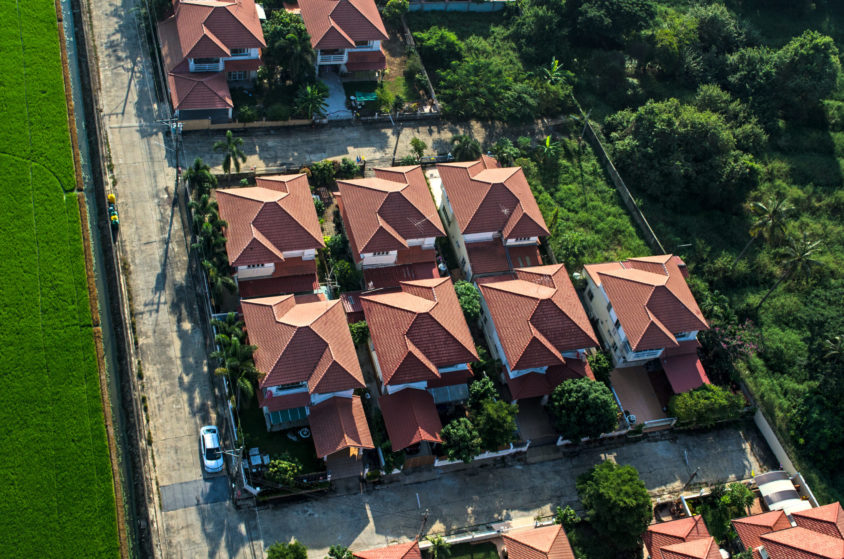You look up and see something that’s not supposed to be on your house or commercial property. Is it dirt, debris, algae, or mildew? You’re not sure but you know you want it gone. Should you clean the roof alone or get a professional to do it? If you want to attempt this project yourself and learn how to clean your roof the right way, then continue reading.
Before You Clean Your Roof
We at Roofing Recovery highly recommend that you hire a professional to do this project, but we know that the adventurous type and those who are financially limited will attempt to do it themselves.
Before you even consider cleaning your own roof, you need to know the risks of this endeavor and what to do to avoid them.

Risk of falling
Use a roof full-body safety harness with a well-secured anchor to protect yourself from falling.
Some roofing materials, especially metal roofs are especially slick, and traveling across them could cause you to slip, resulting in injury or death. Stepping on a loose tile or shingle can cause you to lose your footing. Always exercise extreme caution.
Damaged landscaping
Always water plants thoroughly before beginning your cleaning project and cover them with plastic to protect them. This will hydrate them well, preventing them from drinking up the chemical water and protecting their delicate stems, leaves, and flowers from the detergent raining down on them.
When you wash your roof, the chemicals you use will roll off and onto the surrounding plant life, damaging or killing it if you do not take proper precautions.
Damaged roof materials
Avoid walking on your roof, and when it’s necessary to travel across the top of a building, always take care.
Aluminum roofs dent, tiles crack, and shingles can loosen the granules. No matter what roof you have, walking on it will shorten the roof’s lifespan.
The weather
You should also check the weather predictions for that day. The best weather to clean a roof is on a cloudy day with little to no wind.
You want the cleaning solution to stay up there and sit on the roof for at least 15 minutes. If the sun or wind dries it too quickly, it won’t have time to do its magic. If it rains, you won’t accomplish anything.
Cleaning Your Roof
Every roofing material must be washed differently. We will discuss how to clean a roof, depending on the 3 most common roof types in Florida: asphalt shingle, metal, and clay tile.
Asphalt Shingle Roof Cleaning
- Gently soft-wash or spray a mixture of a 1:1 ratio of chlorine bleach and water. The force of the sprayed solution should not be greater than a garden hose.
- Let it sit for 10 to 15 minutes.
- Rinse it off.
Only apply this once or you risk damaging your roof. This will not remove all the algae, mildew, and mold instantly. What it will do is kill it. During future rain showers and storms, the dead microorganisms will wash away.
Metal Roof Cleaning
- Mix a solution of 5% detergent. That equates to ¼ cup of soap for every 1 gallon of water. Use dish soap, car wash soap, or mild laundry detergent.
- Apply the solution with a nonabrasive sponge, rag, or soft bristle brush.
- Let it sit for 5-10 minutes
- Rinse well with a garden hose.
When you have a painted PVDF metal roof system, sometimes all it needs is a good washing down with water from your garden hose. Really, it might be that simple! Take your time with it and don’t expect instant results.
If you have algae, mold, or mildew on your metal roof, you need to increase the potency of your solution. Instead, add 1 quart of 5% chlorine bleach and ¼ cup powdered laundry detergent to 3 quarts of water.
If you have rust stains, use a solution with a 5:1 ratio of water to citric acid or white vinegar. Don’t let it sit on the spot. Once the rust is removed, quickly rinse it clean.
Clay Tile Roof Cleaning
- Use your ordinary low-pressure garden hose and a brush to clean each tile by hand. Too much water pressure could damage the tile. If you decide to use a commercial product, use one with sodium hydroxide and follow the directions on the label.
- Use plywood that has been foam-treated on the underside to distribute the weight of your body and prevent tiles from being damaged under your shoes.
- When the roof dries, if you use chemicals, you might notice a white chalky substance. They call this efflorescence; it’s completely normal and doesn’t cause any damage, but if you find it unsightly, you will need to buff it out after the roof is entirely dry.
Prevention
Prevention can be a tremendous help. To slow the growth of mold, mildew, and algae, you should:
- Trim trees to give your roof more sunlight during the day.
- Check and maintain your gutter health to make sure that they are draining properly.
- Maintain good roof ventilation.
Consider the Following
- Always consult your roof manufacturer before attempting to clean your roof yourself. They will know the best way to clean their product.
- Do not clean your roof when it lacks integrity. You could cause more injury to your home or business.
If you notice missing shingles or tiles, curling shingles, cracked tiles, rust, broken seams, or other signs of needed roof repair. Find a trusted roofing contractor for this. Roofing Recovery is one of the outstanding roofing contractors in South Florida with superb quality, customer service, and extensive experience. Call 954-799-4069 to request a quote today!























